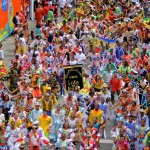The 2014 FIFA World Cup in Brazil, set to take place from June 12th – July 13th, has an incredible 12 host cities making it one of the largest World Cups on the books. These 12 cities are spread throughout the entire country, with most of them (eight in total) lining the eastern South Atlantic Ocean coastline of Brazil. This map (credit to FIFA.com) shows where all 12 of the cities are located in Brazil.
With the distance between the cities, teams will be required to travel farther than any other World Cup in history. The United States World Cup team in particular will travel a whopping 9,000 miles – More than any other country in the tournament. One thing is for certain, fans that are attending the World Cup this year are sure to get a nice tour of the Brazilian country side!
Six of these host cities have built brand new stadiums specifically for the 2014 World Cup, the remaining six all made significant upgrades to existing structures to facilitate the events. The 12 Host Cities for the World Cup are: Manaus, Fortaleza, Natal, Recife, Salvador, Brasilia, Cuiaba, Belo Horizonte, Rio De Janeiro, Sao Paulo, Curitiba, and Porto Alegre. Each of the 12 cities have something unique to offer:
Manaus
Nestled quietly in the Amazon Jungle lies Manaus, the capital city of the Amazonas state. The city of Manaus has a population of 1.5 million, and is really only accessible by boat or airplane. As you would expect for a city located deep in the heart of the Amazon jungle, the climate is quite hot and humid! One of the most unique features of this Amazonian city is the convergence of the Rio Negro and Solimoes rivers. The two rivers run for almost 4 miles without mixing waters. The two rivers meet and form the mouth of the Amazon River, which is the second longest river in the world and the largest in terms of water flow.
Fortaleza
Hovering just south of the Equator sits Fortaleza, the Capital city of Ceara and the 2nd city on our list of 2014 FIFA World Cup Host Cities. Fortaleza is the fifth largest city in Brazil with a population of 2.55 million people. Located on the Atlantic Ocean and known for it’s strong winds Fortaleza is one of Brazil’s premier surfing locations. Culturally it is the center of forro, a type of Brazilian music that encompasses a variety of dance styles and musical beats. Luckily for those attending the World Cup, the city of Fortaleza will be in the height of it’s June festivities allowing visitors to be completely immersed in the city’s quite unique culture.
Natal
Known for its warm waters, sand dunes, and sprawling beaches the 3rd city on our list is Natal. Located in Rio Grande do Norte, Natal is the capital city and has a population of approximately 950,000. It is often praised as the safest capital city in Brazil and has the Via Costeria (Or Coastal Highway) to thank for it’s strong tourism industry. Perhaps one of the most interesting attractions in Natal is the Maior cajueiro do mundo, the world’s largest cashew tree. The picture to the left shows how immense the tree is taking up approximately 90,000 square feet and producing more than 60,000 fruits each year. The tree is estimated to be more than 1,000 years old.
Recife
The 4th city on our list of World Cup Host Cities is Recife, capital city of Pernambuco. It is the 5th largest metropolitan area in Brazil with approximately 3.7 Million people and a serves as a major port city for Brazil on the coast of the Atlantic Ocean. It’s name is derived from the Portuguese word for reef and has some of the most scenic coral reefs in all of Brazil. The Zona Sul (Or South Zone) of the city is where the most picturesque reefs reside. The Boa Viagem Beach, rich with pristine white sands, is the longest urbanized stretch of beach in Brazil and is protected by a coral reef wall.
We hope you enjoyed reading Part 1 of the 2014 FIFA World Cup Host cities, Stay posted for Part 2 which will cover Salvador, Brasilia, Cuiaba, and Belo Horizonte.





 Detroit native Norman Koza, whose love for film got his experience from making his first feature.
Detroit native Norman Koza, whose love for film got his experience from making his first feature. BBA-Banking & Finance from University of Michigan. Lance has written 30 screenplays and directed 4 features.
BBA-Banking & Finance from University of Michigan. Lance has written 30 screenplays and directed 4 features. Email Us
Email Us